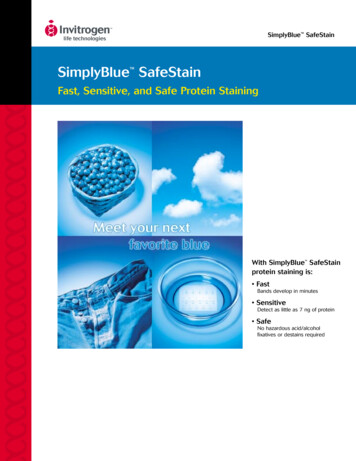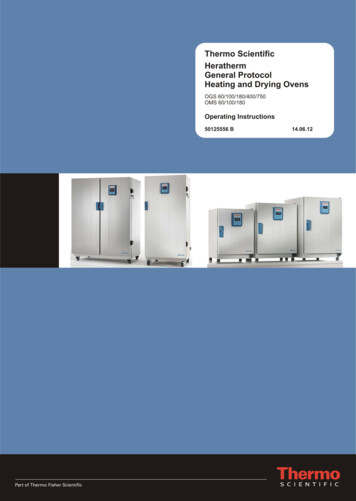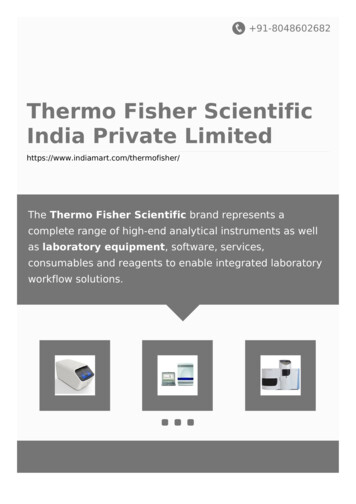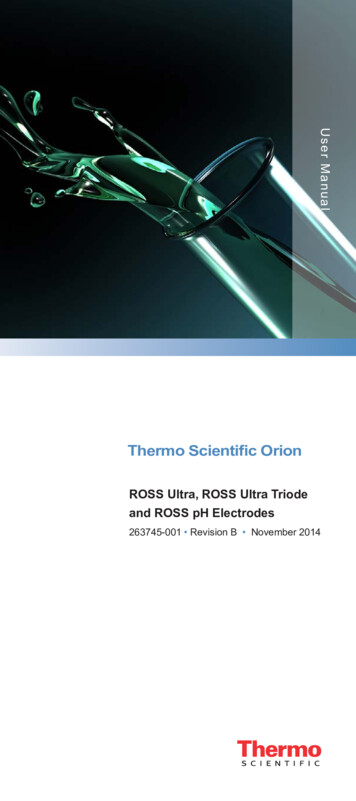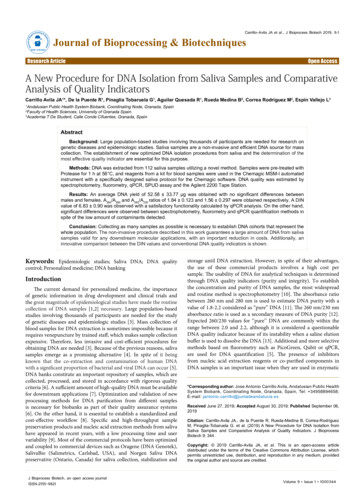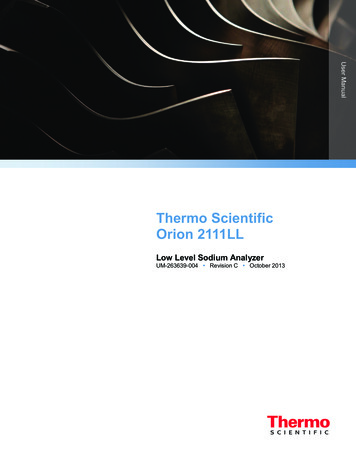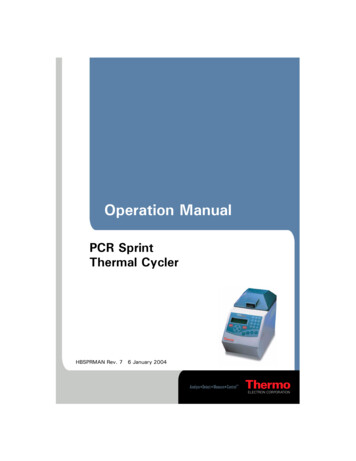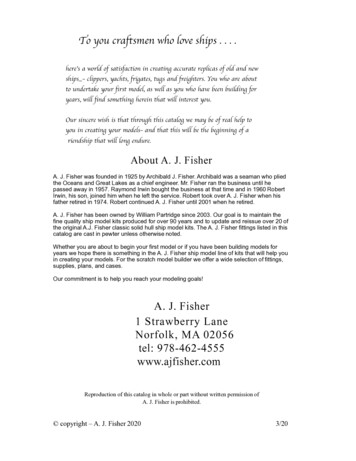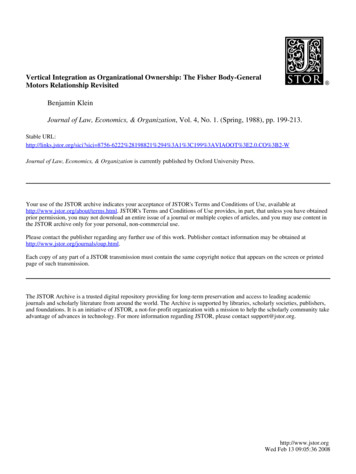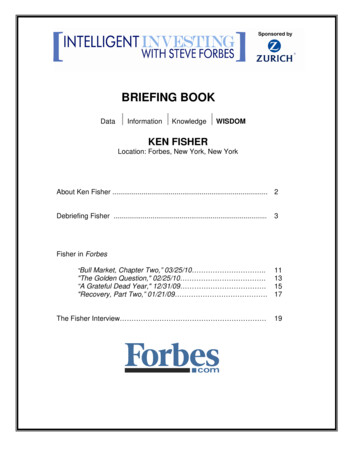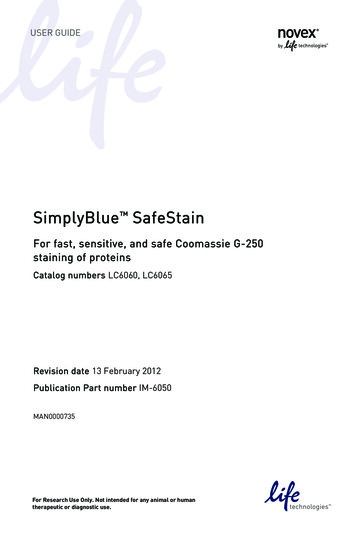
Transcription
USER GUIDESimplyBlue SafeStainFor fast, sensitive, and safe Coomassie G-250staining of proteinsCatalog numbers LC6060, LC6065Revision date 13 February 2012Publication Part number IM-6050MAN0000735For Research Use Only. Not intended for any animal or humantherapeutic or diagnostic use.
ContentsKit Contents and Storage . 4Introduction .5Overview. 5Methods .6Using SimplyBlue SafeStain . 6Appendix.10Technical Support . 10Purchaser Notification . 11Safety Information . 123
Kit Contents and StorageContentsand StorageSimplyBlue SafeStain is available in 2 sizes: 1 L (Cat. no. LC6060)Sufficient stain is provided in 1 L to stain 50 mini-gels 3.5 L with a pump dispenser (Cat. no. LC6065)Upon receipt, store SimplyBlue SafeStain at roomtemperature, 15 C to 30 C. Be sure to keep the bottle cappedwhen not in use. The stain is stable for 6 months whenstored at room temperature.Product Use4For research use only. Not intended for any animal orhuman therapeutic or diagnostic use.
IntroductionOverviewProductDescriptionSimplyBlue SafeStain is a ready-to-use, proprietaryCoomassie G-250 stain that is specially formulated for fast,sensitive detection and safe, non-hazardous disposal. Thisstain does not require the use of methanol or acetic acidwhich must be disposed of as hazardous waste.SimplyBlue SafeStain has been tested for environmentalhazards (see page 12).Proteins stained using the SimplyBlue SafeStain arecompatible with mass spectrometry (MS) analysis.5
MethodsUsing SimplyBlue SafeStainAn alcohol/acetic acid fixing step prior to staining withImportant SimplyBlue SafeStain is NOT required or recommended.BasicProtocolFor general use with 1.0-mm and 1.5-mm Tris-Glycine gels,1.0-mm NuPAGE Novex Gels, and 1.0 mm Tricine mini-gels(8 8 cm). To achieve maximum sensitivity, refer to theprotocol on page 7.After electrophoresis follow the instructions below. Be sure thegel moves freely in water or stain to facilitate diffusion duringall steps. Note: For large format gels, see page 4 forrecommended volumes of water and stain.1.Rinse the mini-gel 3 times for 5 minutes with 100 mLdeionized water to remove SDS and buffer salts, whichinterfere with binding of the dye to the protein. Discardeach rinse.2.Stain the mini-gel with enough SimplyBlue SafeStain( 20 mL) to cover the gel. Stain for 1 hour at roomtemperature with gentle shaking. Bands begin to developwithin minutes. After incubation, discard the stain. Thestain cannot be re-used.Note: The gel can be stained for up to 3 hours, but after3 hours, sensitivity decreases. If you need to leave the gelovernight in the stain, add 2 mL of 20% NaCl (w/v) inwater for every 20 mL of stain. This procedure will notaffect sensitivity.3.Wash the mini-gel with 100 mL of water for 1–3 hours.The gel can be left in the water for several days withoutloss of sensitivity. There is a small amount of dye in thewater that is in equilibrium with the dye bound to theprotein, so proteins remain blue.4.To obtain the clearest background for photography,perform a second 1 hour wash with 100 mL water.Note: Sensitivity will now decrease if the gel is allowedto stay in the water for more than 1 day. Decrease in theamount of free dye in water favors dissociation of thedye from the protein. If you need to store the gel in waterfor a few days, add 20 mL of 20% NaCl.Continued on next page6
Using SimplyBlue SafeStain, ContinuedMaximumSensitivityTo achieve maximum sensitivity, follow the procedurebelow. Adding salt results in significant improvement insensitivity. Values are given for 1.0 mm gels. For 1.5 mmmini-gels, use the value in parentheses.Important: Sensitivity is primarily a function of the dyeprotein interaction, which is unique for each protein.LargeFormat Gels1.Prepare a 20% NaCl (w/v) solution in deionizedwater. You need 20 (30) mL per gel.2.Perform steps 1 and 2, page 6.3.After staining the gel, wash the gel with 100 (150) mLof water for 1 hour.4.Add 20 (30) mL 20% NaCl to the water in step 3 of thisprocedure and continue to wash for an additional2 hours or overnight (if desired).For large format gels, increase the volume of water for eachrinse and wash step, and the volume of stain to achieveoptimal results. Refer to the following table to determine thevolume of water or stain required and follow the BasicProtocol for staining.Gel SizeWaterStain15 15 cm, 1 mm300 mL60 mL15 15 cm, 1.5 mm500 mL100 mL20 20 cm, 1 mm600 mL120 mLContinued on next page7
Using SimplyBlue SafeStain, ContinuedOtherApplicationsInformation for staining IEF Gels, 1.5 mm NuPAGE Novex Gels, and polyvinylidine difluoride (PVDF)membranes is provided in the following table. Follow theBasic Protocol (page 2) using the indicated changes.Note: Staining nitrocellulose and wet PVDF membranesresults in high background and is not recommended.Stain the Zymogram gel with SimplyBlue SafeStain afterrenaturing and developing the gel for enzyme activity.Gel orMembraneFixRinseStainWashIEF Gels100 mL12% TCA for15 minutesBasic Protocol,step 1100 mL stain for1 hourBasic Protocol,step 31.5 mmNuPAGE GelsN/A150 mL waterBasic Protocol,step 2Basic Protocol,step 3Dry PVDFMembraneN/A10–20 mL stainfor 1–2 minutes*10–20 mLwater2 5 minutes1 10 minutesN/A3 1 minuteZymogramGelsN/ABasic Protocol,step 1100 mL stain for1 hourBasic Protocol,step 3*Incubating dry PVDF membranes in stain for 2 minutes results in highbackground.Continued on next page8
Using SimplyBlue SafeStain, ContinuedMicrowaveProcedureThe microwave procedure is fast, takes just 12 minutes, andyields results with sensitivity as low as 5 ng with an additionalincubation with a salt solution. The procedure is for 1.0 mmmini-gels. For 1.5 mm mini-gels, use the values in parentheses.Caution: Use caution while using the stain in a microwaveoven. Do not overheat the staining solutions.1.2.3.4.5.6.7.After electrophoresis, place the gel in 100 mL of ultrapurewater in a loosely covered container and microwave onHigh (950 to 1,100 watts) for 1 minute until the solutionalmost boils.Shake the gel on an orbital shaker for 1 minute(2 minutes). Discard the water.Repeat steps 1 and 2 of this procedure 2 more times.After the last wash, add 20 mL (30 mL) of SimplyBlue SafeStain and microwave on High for 45 seconds to1 minute (1.5 minutes) until the solution almost boils.Shake the gel on an orbital shaker for 5 minutes(10 minutes). Detection limit: 20 ng BSA.Wash the gel in 100 mL of ultrapure water for 10 minuteson a shaker. Detection limit: 10 ng BSA.Add 20 mL of 20% NaCl for at least 5 minutes.Detection limit: 5 ng BSA. The gel can be stored forseveral weeks in the salt solution.Dry the GelIncubating any Coomassie-stained gel in an alcohol solutionwill eventually result in destaining of the bands. If you usethe Gel-Dry Drying Solution from Life Technologies,incubate the gel in the solution for 5 minutes or less.DestainProteinBands forMS AnalysisUse the following general guidelines for destaining theprotein bands prior to MS analysis. Contact your MS facilityor the protein core facility for detailed protocols. Excise the protein band of interest from the gel using aclean scalpel and destain with 10–30% ethanol or20–30% acetonitrile for 10–15 minutes or until clear. Rinse the gel piece in ultrapure water and proceed forMS analysis.9
AppendixTechnical SupportObtainingsupportFor the latest services and support information for alllocations, go to www.lifetechnologies.com/support.At the website, you can: Access worldwide telephone and fax numbers to contactTechnical Support and Sales facilities Search through frequently asked questions (FAQs) Submit a question directly to Technical Support(techsupport@lifetech.com) Search for user documents, Safety Data Sheets (SDSs),vector maps and sequences, application notes,formulations, handbooks, certificates of analysis,citations, and other product support documents Obtain information about customer training Download software updates and patchesSafety DataSheets (SDS)Safety Data Sheets (SDSs) are available atwww.lifetechnologies.com/support.Certificate ofAnalysisThe Certificate of Analysis provides detailed quality controland product qualification information for each product.Certificates of Analysis are available on our website. Go towww.lifetechnologies.com/support and search for theCertificate of Analysis by product lot number, which isprinted on the box.LimitedProductWarrantyLife Technologies Corporation and/or its affiliate(s) warranttheir products as set forth in the Life Technologies’ GeneralTerms and Conditions of Sale found on Life Technologies’website at www.lifetechnologies.com/termsandconditions.If you have any questions, please contact Life Technologiesat www.lifetechnologies.com/support.10
Purchaser NotificationLimited UseLabelLicense:ResearchUse OnlyThe purchase of this product conveys to the purchaser thelimited, non-transferable right to use the purchased amountof the product only to perform internal research for the solebenefit of the purchaser. No right to resell this product orany of its components is conveyed expressly, by implication,or by estoppel. This product is for internal research purposesonly and is not for use in commercial services of any kind,including, without limitation, reporting the results ofpurchaser’s activities for a fee or other form ofconsideration. For information on obtaining additionalrights, please contact outlicensing@lifetech.com or OutLicensing, Life Technologies, 5791 Van Allen Way, Carlsbad,California 92008.11
Safety InformationEnvironmental SimplyBlue SafeStain has been tested by an independentand certified laboratory for environmental hazards. TheTestingresults are summarized in the following table:AnalysisMethodResultsEPA 1010Non-flammable( 144 F)EPA 150.1Non-corrosive (pH 2.1)Corrosivity (by Corrositex )DOT-E 10904Non-corrosiveReactivity (Cyanide and Sulfide)EPA 9010B/9014EPA 9030ANo Reactivity DetectedAquatic Toxicity(fathead minnow; definitive, CAC,Title 22)CA Fish andGameNon-toxicIgnitabilityCorrosivity DisposalInformationFor disposal requirements in your area, consult your localenvironmental safety officer or regional waste waterauthority to determine pH levels that can be discharged intothe sink.SDSRequestsSafety Data Sheets are available atwww.lifetechnologies.com/support. 2012 Life Technologies Corporation. All rights reserved.The trademarks mentioned herein are the property of LifeTechnologies Corporation or their respective owners.Corrositex is a registered trademark of InVitro International.LIFE TECHNOLOGIES CORPORATION AND/OR ITS AFFILIATE(S)DISCLAIM ALL WARRANTIES WITH RESPECT TO THIS DOCUMENT,EXPRESSED OR IMPLIED, INCLUDING BUT NOT LIMITED TO THOSE OFMERCHANTABILITY, FITNESS FOR A PARTICULAR PURPOSE, OR NONINFRINGEMENT. TO THE EXTENT ALLOWED BY LAW, IN NO EVENTSHALL LIFE TECHNOLOGIES AND/OR ITS AFFILIATE(S) BE LIABLE,WHETHER IN CONTRACT, TORT, WARRANTY, OR UNDER ANYSTATUTE OR ON ANY OTHER BASIS FOR SPECIAL, INCIDENTAL,INDIRECT, PUNITIVE, MULTIPLE OR CONSEQUENTIAL DAMAGES INCONNECTION WITH OR ARISING FROM THIS DOCUMENT,INCLUDING BUT NOT LIMITED TO THE USE THEREOF.12
Notes13
Notes14
Headquarters5791 Van Allen Way Carlsbad, CA 92008 USAPhone 1 760 603 7200 Toll Free in USA 800 955 6288For support visitwww.invitrogen.com/support or email techsupport@invitrogen.comwww.lifetechnologies.com
SimplyBlue SafeStain For fast, sensitive, and safe Coomassie G-250 staining of proteins Catalog numbers LC6060, LC6065 Revision date 13 February 2012 Publication Part number IM-6050 MAN0000735. 3
